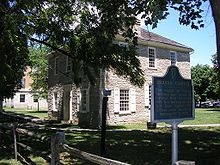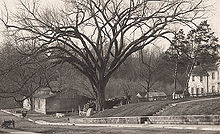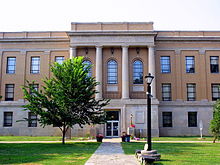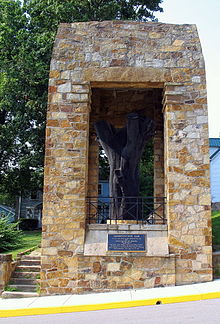- Corydon, Indiana
-
For other uses, see Corydon (disambiguation).
Town of Corydon, Indiana — Town — Downtown Corydon Indiana viewed from the Pilot Knob in the Hayswood Nature Reserve Location in the state of Indiana Coordinates: 38°12′46″N 86°7′31″W / 38.21278°N 86.12528°WCoordinates: 38°12′46″N 86°7′31″W / 38.21278°N 86.12528°W Country United States State Indiana County Harrison Township Harrison Area - Total 1.6 sq mi (4.1 km2) - Land 1.6 sq mi (4.1 km2) - Water 0.0 sq mi (0.0 km2) Elevation 587 ft (179 m) Population (2010) - Total 3,122 - Density 1,707.6/sq mi (659.3/km2) Time zone EST (UTC-5) - Summer (DST) EDT (UTC-4) ZIP code 47112 Area code(s) 812 FIPS code 18-15256[1] GNIS feature ID 0433003[2] Website http://www.thisisindiana.org/ Corydon is a town in Harrison Township, Harrison County, Indiana, United States, founded in 1808, and is known as Indiana's First State Capital. After Vincennes, Corydon was the second capital of the Indiana Territory from May 1, 1813, until December 11, 1816. After statehood, the town was the capital of Indiana until January 10, 1825, when it moved to Indianapolis. The town remains the county seat of Harrison County[3] and had a population of 3,122 at the 2010 census.
Contents
History
Corydon's history dates to the American Revolution, when the area was captured by George Rogers Clark from the British, bringing it under the control of the fledgling United States.
In the early 1800s Edward Smith brought his family to settle the edge of a fertile valley near a large spring, the site of the today's county fairgrounds. William Henry Harrison, Governor of the Indiana Territory, often stopped to rest at their home while travelling to and from Vincennes. Harrison chanced on the spot where Big Indian Creek and Little Indian Creek join to become the Indian Creek. Tradition says he decided to build a town there and asked Edward Smith's daughter, Jenny, to name it. She chose the name Corydon from Harrison's favorite hymn, the Pastoral Elegy.[4]
Early history
Harrison sold the town site to Harvey Heth in 1808, a government surveyor and large landowner. The official founding date is 1808 when Heth was platted the town. Heth donated the town square for public use, and sold individual lots to settlers and the territorial government.[4] In 1809 Corydon was connected by road to Doup's Ferry, fifteen miles (24 km) to the south in Mauck's Port, providing access to the Ohio River for trade. Corydon sent a mounted militia company company nicknamed the Yellow Jackets to support the territorial army in the War of 1812. They fought in the Battle of Tippecanoe, suffering higher casualties than any other unit engaged on there.
In 1811 construction on the first state capitol was begun by Dennis Pennington with the intention of it being used as an assembly building for the territorial legislature. Pennington, a Corydon resident, was the speaker of territorial legislature. Corydon was competing with Madison and Jeffersonville to become the new capital of the territory. Construction, using limestone from a nearby quarry, was completed in 1813.[5] The Governor's Mansion and First State Office Building were built in 1817. The home of Colonel Thomas Posey was also built during this time. Colonel Posey was the son of Thomas Posey, Governor of Indiana Territory from 1813 until 1816. The Grand Masonic Lodge, the first in the state, was built in 1819. Corydon became the second capital of the Indiana Territory on May 1, 1813, when it was moved there from Vincennes to be more centralized with the population of the newly reorganized Indiana Territory.[4]
The state's first constitution was drawn up in Corydon during June 1816. The forty-three delegates representing Indiana Territory's counties where charged with the writing of the state's constitution and met inside the Harrison County Courthouse. Because of cramped conditions inside the courthouse and the summer heat, the delegates often sought refuge outside under a giant elm tree next to Big Indian Creek. This tree is now known as the Constitution Elm, and its trunk is still preserved.[6] The preamble of the constitution began:
We the Representatives of the people of the Territory of Indiana, in Convention met, at Corydon, on Monday the tenth day of June in the year of our Lord eighteen hundred and sixteen
After statehood, Corydon served as the first state capital of Indiana.[7] During the eleven years that Corydon served as a capital it was the center of politics in the state and residents included Davis Floyd, Jonathan Jennings the first Governor of Indiana, and Dennis Pennington first Speaker of the Senate, Ratliff Boon the second governor, and William Hendricks the first Congressman, third governor and Senator.
Dennis Pennington and other representatives from Harrison County in the Indiana General Assembly resisted attempts to move the capital from Corydon; they succeeded in part by their adding a clause to the state constitution during the convention preventing the capital from leaving the town before 1825. Ultimately, as the population center of the state shifted continually northward, it was no longer convenient to have a state capital at the southern extremity of the state. The capital was finally moved to Indianapolis on January 10, 1825.
Post-capital period
On September 11–14, 1860, the first annual county fair was held on Corydon's 36 acres (15 ha) fairgrounds. The fair has been an annual event since then and is the longest continuously running fair in the state.[8] The fairgrounds were built in the southwest corner of Corydon where it is bordered on the south and west by a large ridge which served as a natural grandstands until the first grandstands were built around 1910.[9]
Corydon was the site of the only Civil War battle fought in Indiana. On July 9, 1863, Confederate cavalry led by Brigadier General John Hunt Morgan, aided by the citizens of Brandenburg, Kentucky, crossed the Ohio River into Indiana to begin what is known as "Morgan's Raid". Morgan's 2,500 men were opposed by 400 hastily assembled home guard at the Battle of Corydon. The Union troops were quickly defeated and the town surrendered. Corydon was sacked in retaliation for Union looting in Kentucky. The town's treasury of $690 was seized, and the inmates of the jail were released. Gen. Morgan demanded from $600 to $700 from each mill and shop owner; otherwise their buildings would be burned. Tradition says one Corydon miller overpaid by $200; Morgan promptly returned it to him.[10][11]
The railroad reached Corydon in 1882. Corydon was connected by Southern Railways to the main line running across northern Harrison County at Crandall. The line remained open to passenger traffic until 1996. In 2008, the line was owned by Lucas Oil.
The town of Corydon was shocked by an attempted murder in 1889, the first in the town's history. The two would be murderers, named Devin and Tennyson, were taken from the county jail an angry lynch mob and hung from the old Western Bridge.[12] Although their identities were known, the members of the lynch mob were never prosecuted.
In 1929, a new county courthouse was completed. Prior to that the count government had used the old state capitol building. The old statehouse was converted into an historical memorial.
A fire in 1960 destroyed much of County Fairgrounds, including the grandstand. A grandstand was purchased from the minor league baseball team from Parkway Field in Louisville, Kentucky and is still in use. In 1969, Samuel P. Hays donated the 311-acre (1.26 km2) Hayswood Nature Reserve to the county. Known as Hayswood Park, it is the second largest nature reserve in Harrison County.
The Old Capitol Building is now a state historic site and the downtown area was designated a National Historic District in 1973. The Governor's Headquarters, Constitution Elm, First State Office Building and Posey House are included. The O'Bannon Publishing Company prints the Corydon Democrat', a weekly newspaper. Indiana Governor Frank O'Bannon owned of the publishing company and his wife still lives nearby.
Present town
Because of its historic nature, Corydon is a well-known regional tourist destination. The town hosts weekly events from early spring until late fall, usually centered around the historic town square. Some of the better attended events include the annual Halloween Parade, the Harrison County Fair, summer Friday night band concerts, an annual reenactment of the Battle of Corydon and a long string of country and bluegrass performances. The week-long county fair, held the last week of July at the Harrison County Fairgrounds, is one of the more popular events, with attendance usually over 3,000 per night. The fair includes 4-H exhibits, a midway, demolition derbies, harness racing, and musical entertainment. The fair, first held in 1860, is the oldest, continuous county fair in the state of Indiana. The current town board President is Fred Cammack. He has served in this position since 1975.
In 2008 Corydon began celebrating its bicentennial anniversary with a year of events and the unveiling of a $200,000 bronze statue of the late governor and citizen of Corydon, the Honorable Frank O'Bannon.[13]
Geography
Corydon is located at 38°12′46″N 86°7′31″W / 38.21278°N 86.12528°W (38.212724, -86.125318)[14].
According to the United States Census Bureau, the town has a total area of 1.6 square miles (4.1 km²), all land.
Demographics
As of the 2010 census Corydon had a population of 3,122. The median age was 46.0. The racial and ethnic makeup of the population was 95.2% non-Hispanic white, 0.5% non-Hispanic black, 0.2% Native American, 0.2% Asian, 0.1% Pacific Islander, 0.9% from some other race, 1.2% from two or more races and 2.6% Hispanic or Latino.[15]
As of the census[1] of 2000, there were 2,715 people, 1,171 households, and 674 families residing in the town. The population density was 1,708.1 people per square mile (659.3/km²). There were 1,271 housing units at an average density of 799.6 per square mile (308.6/km²). The racial makeup of the town was 97.27% White, 1.14% African American, 0.41% Native American, 0.11% Asian, 0.04% Pacific Islander, 0.85% from other races, and 0.18% from two or more races. Hispanic or Latino of any race were 1.88% of the population.
There were 1,171 households out of which 25.1% had children under the age of 18 living with them, 40.4% were married couples living together, 13.3% had a female householder with no husband present, and 42.4% were non-families. 37.0% of all households were made up of individuals and 19.0% had someone living alone who was 65 years of age or older. The average household size was 2.17 and the average family size was 2.81.
In the town the population was spread out with 20.1% under the age of 18, 10.2% from 18 to 24, 24.3% from 25 to 44, 20.7% from 45 to 64, and 24.8% who were 65 years of age or older. The median age was 41 years. For every 100 females there were 83.1 males. For every 100 females age 18 and over, there were 80.2 males.
The median income for a household in the town was $33,823, and the median income for a family was $41,630. Males had a median income of $29,159 versus $21,699 for females. The per capita income for the town was $20,740. About 9.8% of families and 10.3% of the population were below the poverty line, including 15.2% of those under age 18 and 14.3% of those age 65 or over.
List of historic sites
- Old State Capitol
- Governor Hendricks Headquarters
- Constitution Elm
- First State Office Building
- Coburn-Porter Law Office
- Posey House
- Battle of Corydon Civil War Memorial Park
- The Kintner House Inn
- Branham Tavern
- Westfall House
- Cedar Glade
- Leora Brown School
- Heth House
- Cedar Hill Cemetery
- Flags Over Corydon
- Harrison County Fairgrounds
Famous residents
- James Best, actor, played Sheriff Rosco P. Coltrane in the Dukes of Hazzard television series, also a character actor on "Gunsmoke"
- Frank O'Bannon, politician, 47th Governor of Indiana
- Arville Funk, author, scholar, Indiana historian
- Spier Spencer, Harrison County's first sheriff and captain of the Yellow Jacket militia company. Killed at the Battle of Tippecanoe and Spencer County is named for him.
- William T. Zenor, four term Congressman
Notes
- ^ a b "American FactFinder". United States Census Bureau. http://factfinder.census.gov. Retrieved 2008-01-31.
- ^ "US Board on Geographic Names". United States Geological Survey. 2007-10-25. http://geonames.usgs.gov. Retrieved 2008-01-31.
- ^ "Find a County". National Association of Counties. http://www.naco.org/Counties/Pages/FindACounty.aspx. Retrieved 2011-06-07.
- ^ a b c Federal Writers' Project, p. 181
- ^ Three Indiana Capitols
- ^ Indiana History Chapter Three
- ^ IN.gov: General Indiana Facts
- ^ http://historic.shcsc.k12.in.us/FAIR/FAIR.HTM County Fair
- ^ Federal Writers Project, p. 184
- ^ ISBN 0-394-46512-1 The Civil War: A Narrative Volume III By Shelby Foote
- ^ Federal Writers' Project, pp. 181–182
- ^ Devin and Tennyson
- ^ O’Bannon Memorial
- ^ "US Gazetteer files: 2010, 2000, and 1990". United States Census Bureau. 2011-02-12. http://www.census.gov/geo/www/gazetteer/gazette.html. Retrieved 2011-04-23.
- ^ 2010 general profile of population and housing characteristics of Corydon from the U.S. census
Sources
- Federal Writers' Project (1947). Indiana. A Guide to the Hoosier State. US History Publishers. ISBN 160354013X. http://books.google.com/books?id=8iFZ90Uw3jEC.
See also
External links
- Town of Corydon, Indiana website
- The Corydon Democrat
- Corydon Central High School
- Harrison County Tourism Website
Other information
Municipalities and communities of Harrison County, Indiana Towns Corydon | Crandall | Elizabeth | Laconia | Lanesville | Mauckport | Milltown‡ | New Amsterdam | New Middletown | Palmyra
Townships Unincorporated
communitiesBradford | Breckenridge | Bridgeport | Buena Vista | Byrneville | Central | Central Barren | Davidson | Depauw | Dixie | Dogwood | Evans Landing | Fairdale | Fishtown | Frenchtown | Glidas | Happy Hollow | Harrison Grange | Little Saint Louis | Locust Point | Lottick Corner | Macedonia | Moberly | Mott Station | New Boston | New Salisbury | Ramsey | Rosewood | Seven Springs | Sugar Grove | Titus | Valley City | White Cloud
Footnotes ‡This populated place also has portions in an adjacent county or counties
Categories:- Corydon, Indiana
- County seats in Indiana
- Towns in Indiana
- Louisville metropolitan area
- Former United States state capitals
- United States colonial and territorial capitals
Wikimedia Foundation. 2010.











